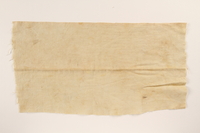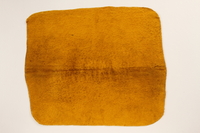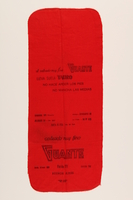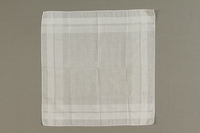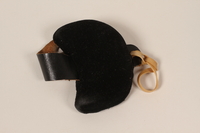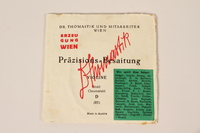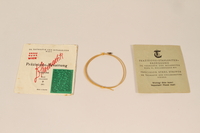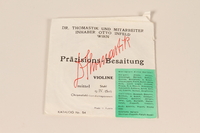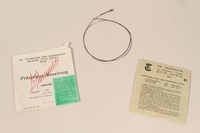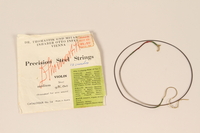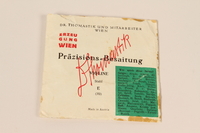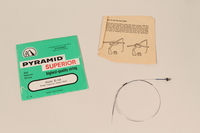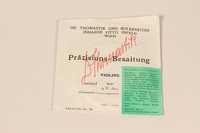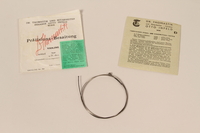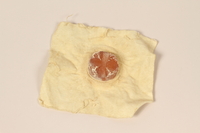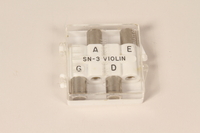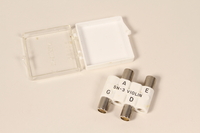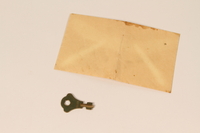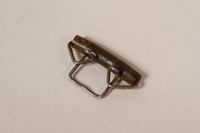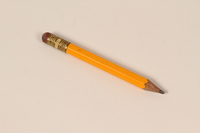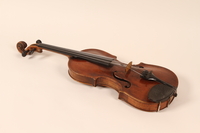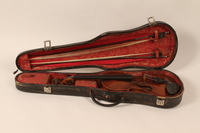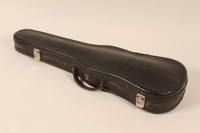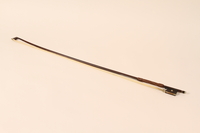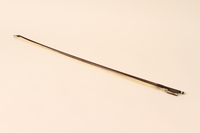Overview
- Brief Narrative
- Violin, bows, case, and parts recovered from the Łódź ghetto in Poland and played by Henry Baigelman after the war. The instruments were hidden in an attic by Henry's brother David in the summer of 1944 after they learned that the Germans were going to destroy the ghetto. They were recovered by his brother-in-law after the city was liberated by the Soviets in January 1945. Two violins were recovered: this one and 2010.472.2; one was played by Henry in the ghetto; the other originally belonged to Henry's cousin. Henry was a professional musician in Łódź when Germany occupied Poland on September 1, 1939. He and his family were imprisoned in the Łódź (Litzmannstadt) ghetto where he and David performed with the orchestra. On June 10, 1944, Himmler ordered the ghetto destroyed. David hid the family instruments. On August 4, 1944, the family was deported to Auschwitz where they were separated. Henry was transferred to Kaltwasser, Flossenberg, and Altenhammer concentration camps. In Altenhammer, the camp supervisor had a violin; Henry played for him and received extra rations. On April 20, 1945, the prisoners were sent on a forced march; they were liberated on April 23 by the US Army. Henry traveled to Cham, Germany, where he organized a band, The Happy Boys, that performed in displaced persons camps. Henry and 2 nephews were the only family members who survived the Holocaust. Henry married and emigrated to the United States in 1949.
- Date
-
use:
before 1944 August-after 1945 May
recovered: after 1945 February
- Geography
-
use:
displaced persons camps;
Germany
recovery: Litzmannstadt-Getto (Łódź, Poland); Łódź (Poland)
- Credit Line
- United States Holocaust Memorial Museum Collection, Gift of the Estate of Henry Baigelman
- Markings
- j. envelope front, printed, black and red ink : DR. THOMASTIK UND MITARBEITER / WIEN / ERZEU / GUNG / WIEN / Präzisions = Besaitung / D Thomastik / VIOLINE / Stahl / Chromstahl / D / (RE) / Made in Austria
k. envelope front, printed, black and red ink : DR. THOMASTIK UND MITARBEITER / INHABER OTTO INFELD / WIEN / Präzisions = Besaitung / D Thomastik / VIOLINE / Stahl / mittel / g. IV. (Sol) / Chromstahl-bandumspannen / Made in Austria / KATALOG Nr. 54
k. envelope back, printed, black ink : In 3 Stärken erhältlich: / weich • gelbes Ende / mittel • schwarzes Ende…. / stark • grünes Ende / IV
l. envelope front, printed, black and red ink : DR. THOMASTIK UND MITARBEITER / INHABER OTTO INFELD / VIENNA / Precision Steel Strings / D Thomastik (cursive, printed over Precision Steel Strings) / VIOLIN / Steel / medium / gIV. (Sol) / chromosteel flat wire wound / CATALOGUE No. 54 Made in Austria
l. envelope back, printed, black ink : Available in 3 tensions: / weak “ yellow end / medium “ black end / strong “ green end / IV
m. envelope front, printed, black and red ink : DR. THOMASTIK UND MITARBEITER / WIEN / ERZEU / GUNG / WIEN / Präzisions = Besaitung / D Thomastik (cursive, printed over Präzisions = Besaitung ) / VIOLINE / Stahl / E / (Mi) / Made in Austria
m. envelope back, printed on sticker, black ink : Benützen Sie / unser Spez.-Kolophonium / Please use our Special Colophony
n. envelope front, printed, black and red ink : Only genuine with Trade Mark /”PYRAMID” / registered Nr. 613626/27 / PRYMID® / SUPERIOR / Soft / Medium / Strong / highest-quality string / Violin E-1st / Finest Precision Drawn Steel / No. 730 / Made in West Germany
n. envelope back, printed, black ink : PYRAMID / ”product of German quality and international fame” / Manufactured by KARL JUNGER / D-8521 BUBENREUTH/Erlangen, P.O. Box 6, West-Germany
o. envelope front, printed, black and red ink : DR. THOMASTIK UND MITARBEITER / INHABER OTTO INFELD / WIEN / Präzisions = Besaitung / D Thomastik (cursive, printed over Präzisions = Besaitung) / VIOLINE / Stahl / mittel / g. IV. (Sol) / Chromstahl-bandumspannen / Made in Austria / KATALOG [Catalog] Nr. 54
o. envelope back, printed, black ink : In 3 Stärken erhältlich: / weich • gelbes Ende / mittel • schwarzes Ende.... / stark • grünes Ende / IV [available in three strengths / medium black finish / strong green end]
p.1. pitch pipe case, top, pressed : SN-3 VIOLIN
p.1. pitch pipe case, top, pressed : WM. KRATT CO. U.S.A. / SUPER / PITCH-PIPE / PAT. APPLD FOR
u. shaft, etched : ?ERNO DE COSTA RICA / “DIVA” 474-No 2 - Contributor
-
Subject:
Henry C. Baigelman
- Biography
-
Henry Chaim Baigelman was born on July 12, 1911, in Łódź, Poland, to Szyman and Rifka. He had a brother David, a composer and conductor, born in March 1887, two other brothers, a sister Rose, and three other sisters. A Polish-Jewish family, they attended synagogue, observed major holidays, and spoke Polish and Yiddish at home. Henry attended shul every Saturday, and received his secular education at a public Polish Gymnasium. They were a family of professional musicians. When Henry was 6, his brother-in-law, Samuel, taught him to play the violin. He joined a conservatory and at 15 began playing both the violin and the saxophone professionally. Szyman died in 1939, before the war started.
On September 1, 1939, Germany invaded Poland. When the bombing began, the Baigelman men fled the city and hid in a field to avoid being caught and sent to a labor camp. Henry promised his mother that he would return that same day and he did. By September 8, the German army occupied Łódź and established a sealed ghetto. Henry, Rifka, David, a younger brother, Rose, her daughter, and extended family members were forced to move into a two room apartment in the ghetto. Henry worked in a kitchen and at a factory that manufactured hats for German soldiers. The administrative head of the ghetto, Mordechai Chaim Rumkowski, established the House of Culture where the Łódź ghetto orchestra performed twice per week; David was the conductor and Henry played the violin.
After Rose died of a brain tumor around 1942, Rifka and Henry cared for her daughter. On June 10, 1944, Heinrich Himmler ordered the destruction of the ghetto. David hid the family instruments, including Henry’s violin, in a factory attic. On August 4, 1944, Henry and 23 family members were deported to Auschwitz concentration camp. They took what they could carry and were forced into covered cattle cars for an overnight ride. Upon arrival, the men, women, and children were separated. Henry was stripped, shaved, disinfected, and given a prison uniform and shoes. He shared a bed with 3 others and did not work. Henry saw the crematoriums, but only heard rumors as to their purpose.
On August 18, Henry was transported to Kaltwasser concentration camp in Germany in a closed cattle car. The prisoners could see people standing along the tracks, watching the train. He arrived on August 21 and was placed in a barracks with 500-600 prisoners. There was no sanitation or toilets, and many were ill. Henry worked building highways for 14 hours a day, 6 days a week; his rations were a small piece of bread and soup each day. In November 1944, he was transported to Flossenberg concentration camp and assigned to hard labor. In February 1945, there was a typhus outbreak in sub-camp Altenhammer and the sick were brought to the hospital at Flossenberg. Henry, his nephew, and 2 cousins were among those selected to replace them. In Atlenhammer, Henry met the camp supervisor, a German political prisoner. He had a violin and accordion and he made Henry and his cousin play daily for him. In return, Henry was well fed and had extra food to share with friends.
On April 16, the German soldiers and guards vacated the camp. The prisoners, having nowhere to go, stayed behind. They found food and ate. After two days, the Germans returned and on April 20, decided to evacuate the camp by ordering a forced march of 12,000 prisoners. They marched at night and hid in orchards during the day. There was no food and they slept in the snow with one blanket. If a prisoner did not get up, he was shot. On April 23, Henry could not get up; his nephew and a friend carried him until he could walk on his own. They were liberated that night by the United States Army. Only 3,000 prisoners survived. The soldiers gave the liberated prisoners milk and food.
Henry and four others found a farm and the farmer provided food and shelter. After a few weeks, they left for the American controlled city of Cham, Germany, and were provided with living accommodations. Henry and two nephews were the only survivors from his immediate family of twenty-three people. While in Cham, Henry met seven other musicians from Łódź. An American army captain and the Cham Burgermeister helped Henry organize an orchestra. Henry procured instruments from Czechoslovakia. His brother-in-law had retrieved the family instruments from the Łódź ghetto following its liberation by the Soviet Army on January 19, 1945. Henry also visited a textile factory and had suits tailor made for performances. The group named themselves the Happy Boys. They specialized in American jazz and performed for American troops. Henry contacted the United Nations Relief and Rehabilitation Administration (UNRAA), which administered displaced persons camps. UNRAA provided the group with an ambulance and driver. They converted it into a tour bus and performed at displaced persons camps and concert halls in large German cities. The Happy Boys were known for their mix of prewar hits, easy listening classics, Jewish songs, and original works about the lives and concerns of Jewish displaced persons. While touring in 1947, Henry married Gita Glazer. The couple had met in Łódź in 1939. The Happy Boys played together for four years.
In 1949, Henry and Gita decided to leave Germany. Emigration to the United States was difficult and the couple decided to go to Israel. As they were making preparations, the quota opened for visas to the US. On August 9, they emigrated to New York from Cham on the USS General Haan. The couple had 2 children. Henry died on June 2, 2002, at the age of 90.
Physical Details
- Classification
-
Personal Equipment and Supplies
- Category
-
Musical Instruments
- Object Type
-
Violin (lcsh)
- Physical Description
- a. Full size, dark brown, varnished wooden violin. The top end is a carved spiral volute scroll extending into a rectangular, slotted peg box with 2 holes on each side. Black painted wooden tuning pegs are inserted into each hole. Four silver metal strings with black and brown thread s are wound around the pegs. Below the peg box the narrow neck attaches to the hourglass shaped body at the top block. The elongated, black painted fingerboard covers the neck and extends over the upper body. The strings extend along the fingerboard and over the light brown, unfinished wooden bridge and are attached to 4 slotted holes on the tailpiece with fine tuners. The bridge is mounted upright between 2 F-shaped sound holes in the body, at the center. The black tailpiece is attached with silver wire to the black endpin. Purfling, a narrow decorative inlay, is carved around the perimeter of the body and back. A black plastic chin rest with an incised diamond pattern is attached to the right of the tailpiece by a silver colored metal adjustable clamp. On the interior left side are 2 light brown rectangular stickers; the top, larger sticker has German text printed in black ink and penciled numbers; the lower stikcer has German fraktur and numbers printed in black ink and numbers handwritten in black ink.
b. Black varnished cloth covered wooden violin shaped case trimmed in black vinyl with a hinged convex lid. All metal attachments are silver colored. On the front are 2 hasp locks and a central semi-circular metal key plate with a sliding button lock. A leather handle is riveted near the center. There are 2 rivets on the lid from the interior brackets. The base has 4 metal feet. Attached to the right side is a metal piece and a vertical black gros grain ribbon with punched holes; it appears to be missing pieces. The lid is attached to the base with 3 metal flap hinges. The interior is lined in red and gold floral brocade. The lid interior holds 2 bows. There are 2 strips of red ribbon attached one each side for placing the bows. On the left is a semi-circular compartment with a divider panel to hold the bow tips; on the right are 2 metal spring brackets to hold the handles. The base has 2 flap covered accessory compartments. The perimeter and bottom is padded. A manufacturer sticker is on the interior of the base.
c. Dark brown varnished wooden bow consisting of a curved stick and animal hair ribbon loosely strung between the tip and frog. The hair is inserted into a square slot on the white plastic wedge shaped tip on the underside of the rectangular head. On the stick end is a rectangular frog with a U-Shaped cut out facing the tip; at the lower leg is a semi-circular metal ferrule to secure the hair to the frog. Extending back from the ferrule is a rectangular slot with a mother of pearl insert and circular mother of pearl side inserts. Above the frog, a brown leather strip is wound around the stick. The stick extends slightly past the frog and is capped with a faceted black wood and metal endscrew with a circular mother of pear insert.
d. Dark brown varnished wooden bow consisting of a curved stick and animal hair ribbon loosely strung between the tip and frog. The hair is inserted into a square slot on the white plastic wedge shaped tip on the underside of the rectangular head. On the stick end is a rectangular frog with a U-Shaped cut out facing the tip; at the lower leg is a semi-circular metal ferrule to secure the hair to the frog. Extending back from the ferrule is a rectangular slot with a mother of pearl insert and circular mother of pearl side inserts. Above the frog, wire is wound around the stick and there is a thickly applied black substance. The stick extends slightly past the frog and is capped with a faceted black plastic and metal endscrew with a circular mother of pear insert.
e. Elongated, rectangular soft red cloth with rounded corners and finished dark red edges. An advertisement in Spanish text is printed on the front and there is a center crease.
f. Rectangular, dark yellow cloth with rounded corners, scalloped short sides, and finished edges. It is stained from use and has a center crease.
g. Rectangular, offwhite cloth, stained from use with 1 selvage and 3 frayed edges, and a center crease.
h. Square, white cotton handkerchief with woven striped and plain bands and finished edges. It is slightly stained and yellowed with age
i. Crescent shaped, black velvet covered shoulder pad on plywood backing. A black leather strap is inserted between the pad and backing; the longer strap end has a keyhole shaped opening; the short end has a circular opening with a rubber band looped through it. The underside of the strap is brown and unfinished.
j. 1. Square, discolored, white paper envelope. On the front is printed English and German product information and a list of musicians in a green rectangle. On the reverse, the envelope flap is ripped and partially detached and there is a sticker remnant with a black letter T superimposed over a red violin.
2. Double sided, offwhite, trifold paper insert has instructions printed in German and English.
3. Coiled, yellow gut violin string is held in a loop by 2 pieces of yellow string.
k. 1. Square, offwhite, paper envelope. On the front is printed English and German product information and a list of musicians in a green rectangle. The reverse has a number, German text, and a Roman numeral.
2. Double sided, light green, single fold paper insert has instructions printed in English and German.
3. Coiled silver steel wire violin string with black thread wound around each end. One end has a circular silver colored metal end cap.
l. 1. Square, white paper envelope, torn and crumpled. On the front is printed English and German product information and a list of musicians in a green rectangle. A number and illegible text are penciled on the front and a square white sticker with German text and numbers is in the upper right. The reverse has a square white sticker with a black letter T superimposed over a red violin, printed English text, and a Roman numeral.
2. Coiled silver steel wire with gut attached at each end; 1 end is wound with red and green thread; the other ends in a loop knot.
m. 1. Square, offwhite paper envelope. On the front is printed English and German product information and a list of musicians in a green rectangle. The reverse has a rectangular yellow sticker with English and German text and a square sticker with a black letter T superimposed over a red violin. The left edge is stained.
2. Double sided, offwhite, trifold paper insert has instructions printed in English and German and the double sided, light green paper insert has printed German product information.
3. Coiled silver steel wire violin string with black thread wound around each end. Attached at 1 end is a rectangular offwhite paper tag with German text, 2 circular pieces of dark brown wood, and a circular silver metal end cap.
n. 1. Square, offwhite and green smooth paper envelope. Printed on the front and reverse is English, German, and Spanish text.
2. Double sided, light brown, single fold paper insert has instructions printed in English and German.
3. Coiled silver steel wire violin string with black thread and wire wound around 1 end and dark blue thread around the other. Attached to 1 end is a small, dark brown wood oval, a black plastic cylinder, and a silver metal end cap with a center hole.
o. 1. Square, offwhite paper envelope. On the front is printed English and German product information and a list of musicians in a light green rectangle. On the reverse is a number, German text, and a Roman numeral.
2. Double sided, light green, single fold paper insert has instructions printed in German.
3. Coiled silver steel wire violin string with black thread wound around each end; 1 end has a silver metal end cap.
p. Circular light brown translucent resin with cross shaped grooves glued to the center of a rectangular, offwhite chamois cloth with frayed edges.
q1. Square, plastic box with a front snap closure and clear hinged lid attached to a white base. Numbers and English text are pressed on the lid and base.
q2. Silver and gold colored metal pitch pipe in a rectangular, white plastic case. The case has 4 alternating cylindrical compartments containing silver colored metal cylinders with oval shaped gold metal inserts; 1end folds up and the other down. Numbers and English text are pressed on both sides of the case.
r1. Small rectangular brown paper envelope with a semi-oval flap, vertical center crease, and yellow triangular shading.
r2. Gold colored metal key with a curved top that tapers to a rectangular shaped bit with 2 rectangular cutouts on each side. English text is engraved on 1 side.
s. Silver colored wire that passes through a brown translucent rubber cylinder. The sides extend down, angle up and bend outward and then down to form a U shape, then extend down to form a rectangular shape.
t. Silver colored metal wire clip with a point at 1 end and a curved hook at the other.
u. Yellow painted wooden No. 2 pencil. There is a gold metal ferrule and short, used, semi-circular pink rubber eraser at the 1 end and a graphite point at the other. Etched Spanish text and numbers are on the shaft. - Dimensions
- a: Height: 23.125 inches (58.738 cm) | Width: 7.875 inches (20.003 cm) | Depth: 3.500 inches (8.89 cm)
b: Height: 4.500 inches (11.43 cm) | Width: 31.125 inches (79.058 cm) | Depth: 10.125 inches (25.718 cm)
c: Height: 29.125 inches (73.978 cm) | Width: 0.500 inches (1.27 cm) | Depth: 1.000 inches (2.54 cm)
d: Height: 29.375 inches (74.613 cm) | Width: 0.500 inches (1.27 cm) | Depth: 1.125 inches (2.858 cm)
e: Height: 28.125 inches (71.438 cm) | Width: 11.500 inches (29.21 cm)
f: Height: 15.125 inches (38.418 cm) | Width: 12.375 inches (31.433 cm)
g: Height: 18.250 inches (46.355 cm) | Width: 9.750 inches (24.765 cm)
h: Height: 18.375 inches (46.673 cm) | Width: 18.750 inches (47.625 cm)
i: Height: 6.625 inches (16.827 cm) | Width: 3.625 inches (9.208 cm) | Depth: 1.000 inches (2.54 cm)
j: Height: 3.875 inches (9.843 cm) | Width: 3.875 inches (9.843 cm)
k: Height: 3.875 inches (9.843 cm) | Width: 3.875 inches (9.843 cm)
l: Height: 4.000 inches (10.16 cm) | Width: 4.000 inches (10.16 cm)
m: Height: 3.875 inches (9.843 cm) | Width: 3.875 inches (9.843 cm)
n: Height: 3.875 inches (9.843 cm) | Width: 3.875 inches (9.843 cm) | Depth: 0.060 inches (0.152 cm)
o: Height: 3.875 inches (9.843 cm) | Width: 3.875 inches (9.843 cm) | Depth: 0.060 inches (0.152 cm)
p: Height: 4.750 inches (12.065 cm) | Width: 5.125 inches (13.017 cm) | Depth: 0.500 inches (1.27 cm)
q: Height: 2.125 inches (5.398 cm) | Width: 2.000 inches (5.08 cm) | Depth: 0.625 inches (1.588 cm)
r1: Height: 2.500 inches (6.35 cm) | Width: 4.250 inches (10.795 cm)
r2: Height: 1.125 inches (2.858 cm) | Width: 0.750 inches (1.905 cm) | Depth: 0.125 inches (0.318 cm)
s: Height: 0.625 inches (1.588 cm) | Width: 1.125 inches (2.858 cm) | Depth: 0.375 inches (0.953 cm)
t: Height: 2.750 inches (6.985 cm) | Width: 0.625 inches (1.588 cm) | Depth: 0.125 inches (0.318 cm)
u: Height: 3.500 inches (8.89 cm) | Width: 0.375 inches (0.953 cm) | Depth: 0.375 inches (0.953 cm) - Materials
- a : wood, varnish, plastic, metal, wire
b : wood, leather, metal, brocade, pressure-sensitive tape
: ribbon
c : wood, hair, metal, varnish, mother of pearl, plastic
d : wood, hair, metal, varnish, mother of pearl, plastic
e : cloth, ink
f : cloth
g : linen
h : cloth
i : velvet, plywood, leather, rubber, adhesive
j : paper, ink, gut, adhesive
k : paper, ink, steel, chrome
l : paper, ink, steel, chrome, gut, adhesive
m : paper, ink, steel, wood, plastic
n : paper, ink, steel, wood, plastic
o : paper, ink, steel
p : resin, felt, adhesive
q : plastic, metal, ink
r : metal
s : metal, rubber - Inscription
- a. violin, interior, left side, printed, black ink : Cmon Schödler, Hochfurstl. Hof / Lauter [illegible] Geigenmacher zu / V(?)assau im Jahre 178.5
a. violin, interior, left side, handwritten, black ink : Repariert / Kessler, Hofinstrumentenmacher [repaired / Kessler, court instrument maker]
a. violin, interior left, pencil : 19 / MANNHEIM.38 [or 30?]
a. violin, interior, left side, printed in German fraktur and handwritten in black ink: (illegible German fraktur) / 178.5 (8.5 handwritten)
e. cloth front, printed, black ink : el calzado muy fino / GUANTE / LLEVA SUELA TAURO / NO HACE ARDER LOS PIES / NO MANCHA LAS MEDIAS / CORDOBA 1171 - Rosarto CORDOBA - RIVADAVIA 68 / BELGRANO 114 - San Isidro LA PLATA - 50No 628 / SANTE FE 1725 Mar del Plata / calzado muy fino / GUANTE / Avda. Alvear 1820 Florida 271 Cab(?)(?)do 1702 / BUENOS AIRES / 2 lines illegible text (very fine footwear (in cursive) / glove / Takes Taurus soles / does not burn the feet / does not stain tights / address / very fine footwear (in cursive) / glove
l. envelope front, handwritten, blue ink : 12 (illegible text)
l. envelope front, printed on sticker, red ink : LEHMAN / 4652 K2 / ¢4.50 / ?G?11.75
m. envelope back, printed on sticker, black ink : Benützen Sie / unser Spez.-Kolophonium / Please use our Special Colophony
Rights & Restrictions
- Conditions on Access
- No restrictions on access
- Conditions on Use
- No restrictions on use
Keywords & Subjects
Administrative Notes
- Legal Status
- Permanent Collection
- Provenance
- The violin, bows, case, and accessories were donated to the United States Holocaust Memorial Museum in 2010 by Riva Berelson and Simon Baigelman on behalf of the Estate of Henry Baigelman.
- Funding Note
- The cataloging of this artifact has been supported by a grant from the Conference on Jewish Material Claims Against Germany.
- Record last modified:
- 2022-07-28 20:13:45
- This page:
- https://collections.ushmm.org/search/catalog/irn43164
Also in Henry Baigelman collection
The collection consists of three musical instruments: two violins with fitted cases and a saxophone with a fitted case, as well as instrument accessories, relating to the experiences of Henry Baigelman and his family before and during their incarceration in the Łódź Ghetto in Poland, prior to their deportation to various concentration camps during the Holocaust and to Henry's recovery of the instruments and their use in his band, The Happy Boys, that toured displaced persons camps after the war.
Date: 1945 May
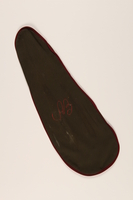
Violin, bows, case and accessories recovered from Łódź ghetto and played in DP camps by a Polish Jewish musician
Object
Violin, case, and parts recovered from the Łódź ghetto in Poland and played by Henry Baigelman after the war. The instruments were hidden in an attic by Henry's brother David in the summer of 1944 after they learned that the Germans were going to destroy the ghetto. They were recovered by his brother-in-law after the city was liberated by the Soviets in January 1945. Two violins were recovered: this one and 2010.472.2; one was played by Henry in the ghetto; the other originally belonged to Henry's cousin. Henry was a professional musician in Łódź when Germany occupied Poland on September 1, 1939. He and his family were imprisoned in the Łódź (Litzmannstadt) ghetto where he and David performed with the orchestra. On June 10, 1944, Himmler ordered the ghetto destroyed. David hid the family instruments. On August 4, 1944, the family was deported to Auschwitz where they were separated. Henry was transferred to Kaltwasser, Flossenberg, and Altenhammer concentration camps. In Altenhammer, the camp supervisor had a violin; Henry played for him and received extra rations. On April 20, 1945, the prisoners were sent on a forced march and were liberated on April 23 by the US Army. Henry traveled to Cham, Germany, where he organized a band, The Happy Boys, that performed in displaced persons camps. Henry and 2 nephews were the only family members who survived the Holocaust. Henry married and emigrated to the United States in 1949.
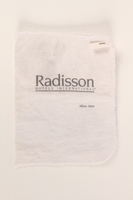
Saxophone, case and accessories used by a Polish Jewish musician in a band that toured DP camps
Object
Saxophone, case, and parts acquired and used by Henry Baigelman after the war. Henry was a professional musician in Łódź when Germany occupied Poland on September 1, 1939. He and his family were imprisoned in the Łódź (Litzmannstadt) ghetto where he and his brother David performed with the orchestra. On June 10, 1944, Himmler ordered the ghetto destroyed, David hid the family instruments. On August 4, 1944, the family was deported to Auschwitz where they were separated. Henry was transferred to Kaltwasser, Flossenberg, and Altenhammer concentration camps. In Altenhammer, the camp supervisor had a violin; Henry played for him and received extra rations. On April 20, 1945, the prisoners were sent on a forced march and liberated on April 23 by the US Army. Henry traveled to Cham, Germany, where he organized a band, The Happy Boys, that performed in displaced persons camps. Two of the violins that were hidden in the ghetto were recovered by Henry's brother-in-law after the city was liberated by the Soviets in January 1945. See records 2010.472.1 and 2010.472.2; one was played by Henry in the ghetto; the other originally belonged to Henry's cousin. Henry and 2 nephews were the only family members who survived the Holocaust. Henry married and emigrated to the United States in 1949.

